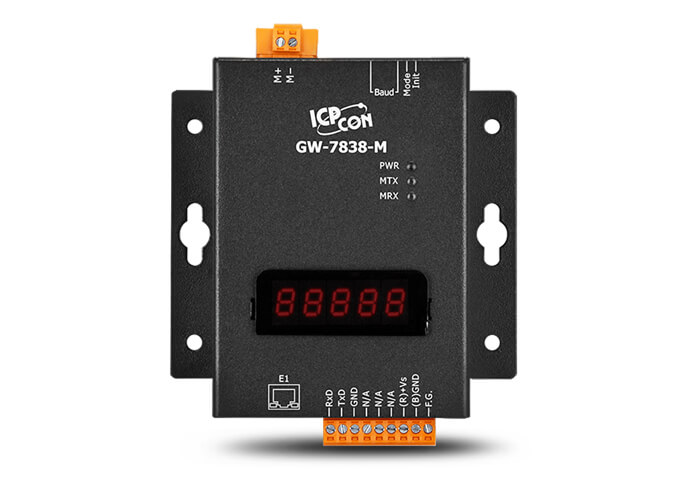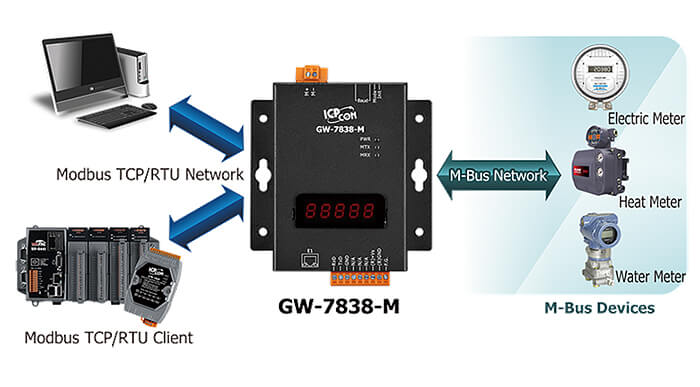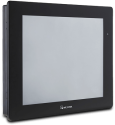
ICP DAS has presented a new gateway GW-7838-M designed to convert data via the M-Bus protocol to Modbus TCP/RTU, allowing direct transfer of data from meters and counters to the control system.
Description of the M-Bus
M-Bus (Meter-Bus) is a communication interface widely used in various meters such as electricity meters, water meters, heat meters, etc. Ease of installation and reliability are the most important features of this bus.
The M-Bus was originally described in the European standard EN1434-3 and its Russian version GOST R EN 1434-3 for data exchange with heat meters. Subsequently, the M-Bus protocol was also standardized in EN13757 for use with other measuring instruments and remote readings.
The M-Bus protocol can be used not only on the wired physical layer, but also on other physical layers, including optical, radio channel, current loop, and alternative wired physical layer.
| OSI layer | Standard |
| Application layer |
EN1434-3 EN13757-3 |
| Executive level | No |
| Session layer | No |
| Transport layer | No |
| Network layer | Option |
| Channel layer |
EN1434-3 EN13757-2 |
| Physical layer |
EN1434-3 EN13757-2 |
M-Bus parameters
M-Bus is a half-duplex data bus that operates at speeds from 300 to 9600 bps. It is compatible with standard speed UART ports of computers and microcontrollers that are the source and destination of data. The recommended cable type is a standard telephone cable.
In this communication system, the master uses different line voltages to transmit logic ones and zeros. A logic one corresponds to a voltage of 36 V, and a logic zero corresponds to a range of 12 to 24 V. While slave devices use different current consumption to transmit logic ones and zeros. When transferring a logical unit, the current consumption remains unchanged and should not exceed 1.5 mA. When a logic zero is sent, the slave device increases the current consumption to 11-20 mA, and the master defines this increase as a logic zero.
The range of the M-Bus bus in the standard configuration is up to 1000 meters. Operating range of the slave device to the signal repeater up to 350 m.
| Number of meters/counters | Max. range | Total cable length | Cable section | Transmission speed |
|---|---|---|---|---|
| 64 | 350 m | <= 1 km | 0.5 mm2 | 38400 bit/s |
| 64 | 350 m | <= 4 km | 0.5 mm2 | 9600 bit/s |
| 64 | 1000 m | <= 4 km | 0.5 mm2 | 2400 bit/s |
| 64 | 3000 m | <= 5 km | 1.5 mm2 | 2400 bit/s |
| 250 | 350 m | <= 1 km | 0.5 mm2 | 9600 bit/s |
| 250 | 350 m | <= 4 km | 0.5 mm2 | 2400 bit/s |
Specifications and features of GW-7838-M
GW-7838-M supports up to 100 M-Bus devices. After the initial setup using the M-Bus utility, the GW-7838-M automatically reads the meter data. Controller, SCADA system or PC as Modbus TCP/RTU master can easily access meter data via Ethernet or RS-232 connection.

- M-Bus support: EN-13757, CJ/T-188
- Support Modbus TCP/RTU function code 0x03 and 0x04 to read meter data
- The device supports up to 100 M-Bus slaves.
- M-Bus interface protection against overcurrent and short circuit protection
- Ability to update firmware via serial port
- Watchdog timer
Also, ICP DAS has previously released I-7590, an interface converter RS-232/422/485 to M-Bus Master, allowing PC to poll M-Bus devices via COM port.
Soon, an M-Bus repeater I-3591 will also be available for order.
For further technical information, inquiries about offers or placement of orders, please contact our sales

